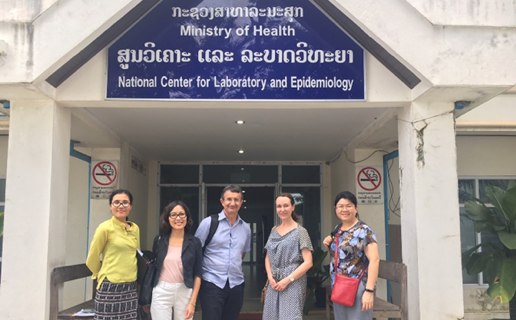23 Aug 2018
Viral hepatitis situation assessment in Lao People’s Democratic Republic
Viral hepatitis represents a major cause of mortality in Lao People’s Democratic Republic (PDR) with 8,545 deaths due to chronic hepatitis recorded in 2015 [1].
Suellen Nicholson, Head of Serology, Victorian Infectious Diseases Reference Laboratory, The Royal Melbourne Hospital at the Doherty Institute.
Estimates of the prevalence of chronic HBV infection are 8.74% (558,710 cases) and 1.7% HBsAg positivity among 5-9 year olds (2012) [1,2]. For HCV infection, disease burden epidemic estimates show 0.7% prevalence (48, 600 cases) of chronic HCV infection [1,3]. In Lao PDR, 41% of mortality due to cancer is liver cancer, which is the second highest rate globally [1].
Hepatitis B virus (HBV) and hepatitis C virus (HCV) are the main causes of liver cancer and cirrhosis. Asia and the Pacific regions carry 45% of global disease burden of viral hepatitis [4]. In Asia, HBV is endemic and is transmitted primarily from mother-to-child. HCV is primarily transmitted through unsafe medical injections. Direct acting antivirals (DAA) cure 95% of HCV infections, while HBV requires long term treatment for eligible patients. Early testing and treatment are critical to prevent disease progression and development of liver cancer. The Ministry of Health (MOH) of Lao PDR is committed to improving access to hepatitis treatment for the people of Lao.
Last month as a member of the WHO Collaborating Centre for Viral Hepatitis at the Doherty Institute WHO Collaborating Centre for Viral Hepatitis, I was invited to Lao PDR to work with other WHO members to collaborate with the MOH to conduct a systematic situation analysis that could help inform a national response and design appropriate interventions within existing health systems to address the hepatitis epidemics.
The mission took place from 11-15 June 2018, and included consultation and field visits by the core assessment team to approximately 30 key sites, both national and international organizations (including the private sector) in the capital Vientiane, and a provincial district site. The assessment team were well received and were able to provide a thorough situational analysis of viral hepatitis in Lao PDR. Gaps were identified between the WHO recommended benchmark and the current situation, with recommendations proposed for prevention, testing and treatment, and surveillance and monitoring. In conjunction with Lao PDR MOH, this is a step towards ultimately eliminating hepatitis B and C.

From left to right: Chintana Somkhane (WHO Lao), Linh-Vi Le (WHO WPRO), Laurent Ferradini (WHO), Suellen Nicholson (WHO PDI), Polin Chan (WHO WPRO)
[1] Unpublished reference: World Health Organization – Situational analysis for viral hepatitis Lao PDR. Mission debrief 11-15 June, 2018. Linh-Vi, Le, WHO Western Pacific Region (WPRO). Note: chronic HBV and HCV rates are preliminary disease burden estimates

